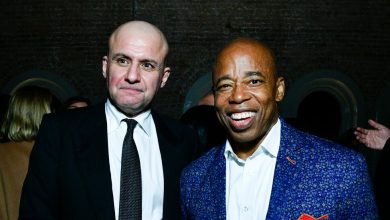Bob Dylan Sings, and Talks, on These Tapes From 62 Years Ago

Good morning. It’s Monday. Today we will find out how a sculptor in Detroit came to have master tapes of Bob Dylan’s first album. They could sell for as much as $1.2 million at an auction this week.

Credit…Guernsey’s
Stephen Handschu has moved at least eight times since he was 19 years old. Each time he has packed up three squarish boxes that someone left in his very first place, a studio in the East Village.
The boxes contain relics from the analog era: open-reel tapes. Handschu says they are master tapes of Bob Dylan’s first album, recorded in November 1961 and released in 1962 under the title “Bob Dylan.” Guernsey’s — the Manhattan auction house that has found buyers for everything from Rembrandts and Renoirs to Elizabeth Taylor’s Rolls-Royce and a diamond necklace made for Diana, Princess of Wales — plans to sell the tapes on Thursday with a starting bid of $200,000. Guernsey’s says they could go for as much $1.2 million. Arlan Ettinger, the president of the company, said that the three reels could have been duplicates of the masters for the album, but no other tapes from “Bob Dylan” have been found.
There is more on the tapes than songs like “House of the Risin’ Sun” and “Highway 51.” They have a separate track with a conversation between Dylan and the producer John Hammond, who promoted Dylan’s career, as he had done for Count Basie and Billie Holiday and would later do for Bruce Springsteen. Hammond was in the control room, chatting with Dylan after each take on a talk-back circuit.
Handschu had not known that anything was on the tapes in the summer of 1966, when the man who had stayed in his studio apartment moved on. The man had been working as a security guard at a recording studio used by Columbia Records.
“He comes home one night and says, ‘Look at this,’” Handschu said. “Handwritten on the boxes are ‘Bob Dylan 1, 2 and 3.’ I’m going, What’s this? He goes, ‘I’m not entirely sure.’ He said: ‘There was a pile of boxes of tapes by the incinerator, and these were on the top — and you know how I like Bob Dylan. So I asked the engineer, What’s going on?’”
The engineer said that the tapes had been bulk-erased. Whatever music had been on them was gone, the engineer said, and the tapes could not be reused. So Handschu’s friend took them home.
“We’re going, There’s probably nothing on them, they were throwing them away, they can’t be worth anything, but these objects were there when Dylan recorded his first album,” Handschu said. They could not play them: The 10-inch reels were too big for Handschu’s tape recorder.
Handschu said that he had tried to find the man every few years since he had left, with no success.
“He didn’t say, ‘I’ll be back for these tapes,’” Handschu said. “He said something offhand like, ‘Steve, try not to throw them away.’ There was no big deal about it. I thought for most of the years I’ve had these tapes, I was being irrational to keep them. Every time I moved, my wife, my girlfriend, my daughter — someone — would look at me and say, ‘What are you dragging these around for?’ I would say, ‘I don’t know, but I can’t make myself throw them away.’”
He still had not listened to them by the early 2000s, when he was working with the Chicago Board of Elections on audio ballots required by the Help America Vote Act, a federal law intended to prevent a rerun of the problems in Florida during the 2000 election. Handschu asked the recording engineer whether he had a machine that would play open-reel tapes.
“He said it would need some work” and asked what might be on the tapes that would be worth that much work,” Handschu recalled, adding, “I tell him, Dylan’s master tape.”
The recording engineer, Scott Steinman, spent two months getting the machine in shape. Then, finally, Dylan’s voice could be heard, singing and talking with Hammond.
Handschu, who now lives in Detroit, worked as a civil rights activist and a union organizer as well as a sculptor. He has been blind all his life and said that he had done things that were “more important to me than making money was.” The Detroit Free Press, which reported on the sale last month, said that he lived in “a subsidized studio apartment in downtown Detroit where the elevator smells like a garbage chute and hookers were only recently discouraged from conducting business in the laundry room.”
Handschu acknowledged that the auction could change his life, though he added, “I’m not counting chickens.” He said that some money from the sale of the tapes would go to Steinman and some to Eye Learn Cares, a Detroit nonprofit that offers disability awareness training. “The first priority is paying off old bills, the things you have when you don’t have money,” he said.
Weather
Expect a chance of rain, with wind gusts and temperatures in the low 40s. At night it will be mostly clear, with temperatures in the low 30s.
ALTERNATE-SIDE PARKING
In effect until Dec. 25 (Christmas Day).
The latest New York news
-
A pop-up market on Randall’s Island: Since early October, an ecosystem of barbers, vendors and chefs has sprung up outside one of the city’s largest migrant shelters.
-
Rebranding a state: Connecticut has retired “Still Revolutionary” as a slogan in favor of twin marketing campaigns: “Make It Here” and “Find Your Vibe.”
-
Private universities and their tax breaks: Columbia University and New York University would lose $327 million in tax breaks under proposed legislation that would eliminate property tax breaks for the two institutions. The proposal calls for the money to be redistributed to the City University of New York.
-
A holiday boom, sort of: After three years of less foot traffic and less spending in Manhattan, things seem to be looking up. But it’s not 2019 again.
METROPOLITAN diary
Riding downtown
Dear Diary:
I was headed downtown on the 2 train when a college-age girl sitting nearby began to sob.
I moved over to sit on her right side as a woman sitting to her left began to comfort her.
The girl said she was overwhelmed with anxiety and on the way to her therapist. A man sitting across from her offered her an unopened cold soda, which she accepted.
There we were on the train, four of us together, one of us in crisis. The situation seemed so precarious that I skipped my stop to stay by the young woman’s side. Her distress was palpable.
I, the woman on the left and the man offered her encouraging words in low tones. It seemed to help. She began to breathe normally and calm down.
We reached Wall Street, the last stop in Manhattan. I didn’t have time to go to Brooklyn and get back to my destination in time.
Preparing to get off the train, I asked the young woman if she was going to be OK. As I did, the woman on her left said she needed to get off, too. The man sitting across from us said he felt bad because he also needed to get off.
We all asked the young woman if she was going to be OK. She nodded, but sniffled.
The three of us stood, hesitating as the doors opened. Suddenly, a woman swooped in from somewhere down the car and sat down in the seat I was vacating.
“I got her,” the woman said, smiling.
— Isabel Walcott Draves
Illustrated by Agnes Lee. Send submissions here and read more Metropolitan Diary here.
Glad we could get together here. See you tomorrow. — J.B.
P.S. Here’s today’s Mini Crossword and Spelling Bee. You can find all our puzzles here.
Melissa Guerrero and Ed Shanahan contributed to New York Today. You can reach the team at nytoday@nytimes.com.
.




